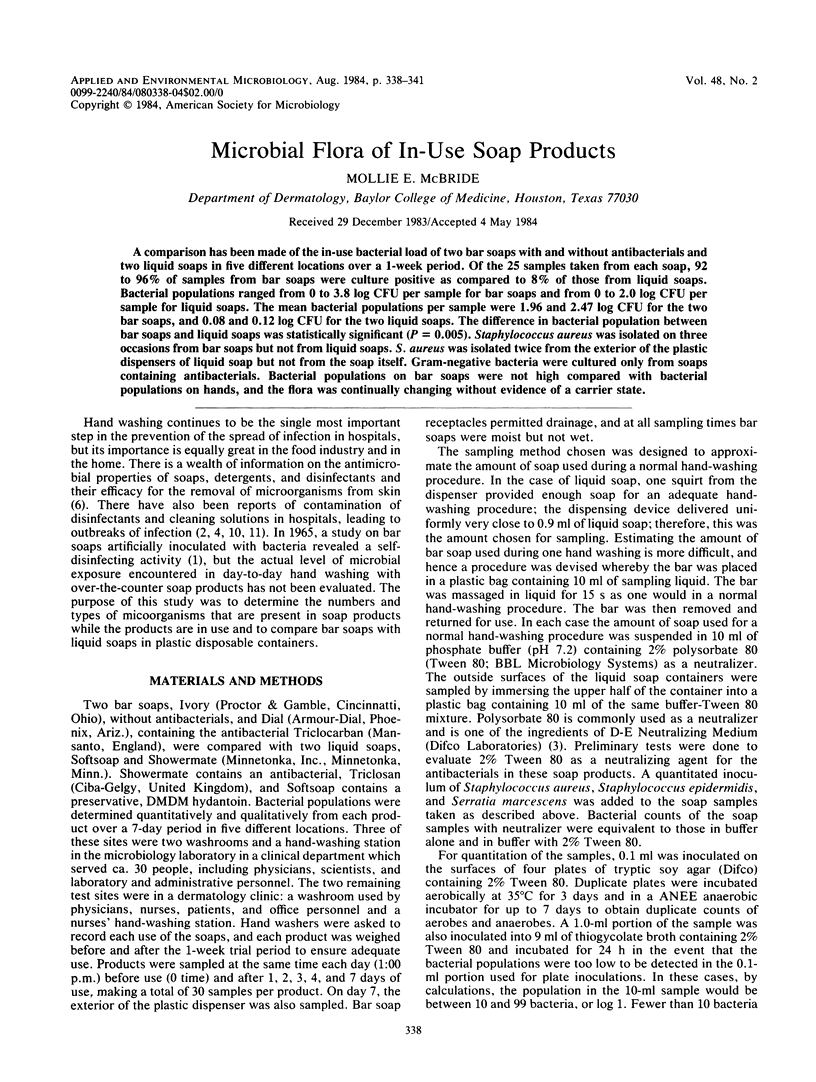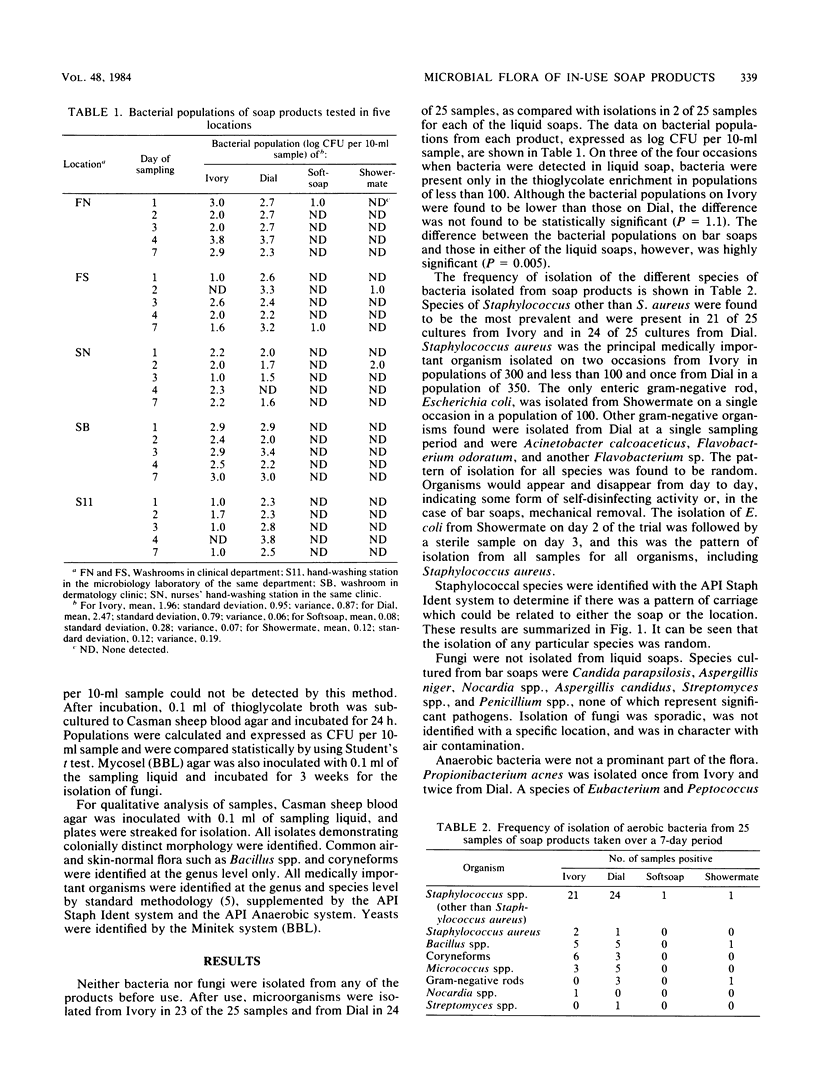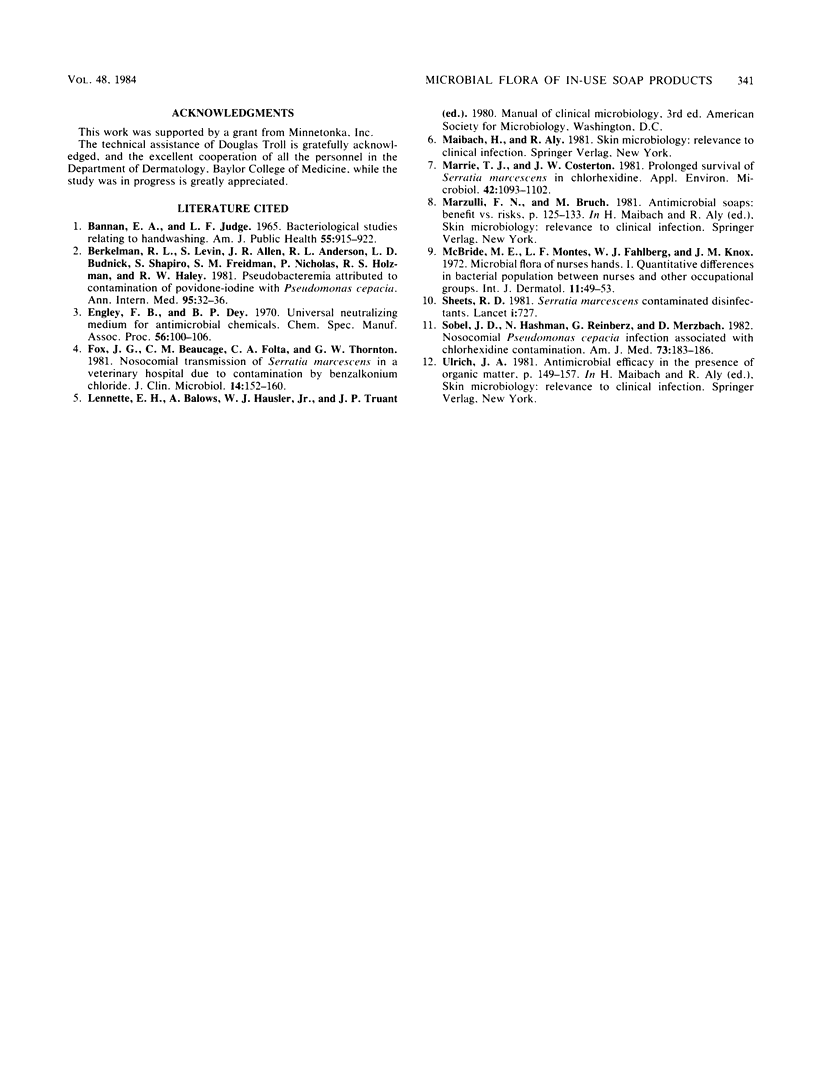Abstract
A comparison has been made of the in-use bacterial load of two bar soaps with and without antibacterials and two liquid soaps in five different locations over a 1-week period. Of the 25 samples taken from each soap, 92 to 96% of samples from bar soaps were culture positive as compared to 8% of those from liquid soaps. Bacterial populations ranged from 0 to 3.8 log CFU per sample for bar soaps and from 0 to 2.0 log CFU per sample for liquid soaps. The mean bacterial populations per sample were 1.96 and 2.47 log CFU for the two bar soaps, and 0.08 and 0.12 log CFU for the two liquid soaps. The difference in bacterial population between bar soaps and liquid soaps was statistically significant (P = 0.005). Staphylococcus aureus was isolated on three occasions from bar soaps but not from liquid soaps. S. aureus was isolated twice from the exterior of the plastic dispensers of liquid soap but not from the soap itself. Gram-negative bacteria were cultured only from soaps containing antibacterials. Bacterial populations on bar soaps were not high compared with bacterial populations on hands, and the flora was continually changing without evidence of a carrier state.
Full text
PDF



Selected References
These references are in PubMed. This may not be the complete list of references from this article.
- BANNAN E. A., JUDGE L. F. BACTERIOLOGICAL STUDIES RELATING TO HANDWASHING. 1. THE INABILITY OF SOAP BARS TO TRANSMIT BACTERIA. Am J Public Health Nations Health. 1965 Jun;55:915–922. doi: 10.2105/ajph.55.6.915. [DOI] [PMC free article] [PubMed] [Google Scholar]
- Berkelman R. L., Lewin S., Allen J. R., Anderson R. L., Budnick L. D., Shapiro S., Friedman S. M., Nicholas P., Holzman R. S., Haley R. W. Pseudobacteremia attributed to contamination of povidone-iodine with Pseudomonas cepacia. Ann Intern Med. 1981 Jul;95(1):32–36. doi: 10.7326/0003-4819-95-1-32. [DOI] [PubMed] [Google Scholar]
- Fox J. G., Beaucage C. M., Folta C. A., Thornton G. W. Nosocomial transmission of Serratia marcescens in a veterinary hospital due to contamination by benzalkonium chloride. J Clin Microbiol. 1981 Aug;14(2):157–160. doi: 10.1128/jcm.14.2.157-160.1981. [DOI] [PMC free article] [PubMed] [Google Scholar]
- Marrie T. J., Costerton J. W. Prolonged survival of Serratia marcescens in chlorhexidine. Appl Environ Microbiol. 1981 Dec;42(6):1093–1102. doi: 10.1128/aem.42.6.1093-1102.1981. [DOI] [PMC free article] [PubMed] [Google Scholar]
- McBride M. E., Montes L. F., Fahlberg W. J., Knox J. M. Microbial flora of nurses' hands. I. Quantitative differences in bacterial population between nurses and other occupational groups. Int J Dermatol. 1972 Jan-Mar;11(1):49–53. doi: 10.1111/j.1365-4362.1972.tb01721.x. [DOI] [PubMed] [Google Scholar]
- Sheets R. D. Serratia marcescens contaminated disinfectants. Lancet. 1981 Mar 28;1(8222):727–727. doi: 10.1016/s0140-6736(81)92007-9. [DOI] [PubMed] [Google Scholar]
- Sobel J. D., Hashman N., Reinherz G., Merzbach D. Nosocomial Pseudomonas cepacia infection associated with chlorhexidine contamination. Am J Med. 1982 Aug;73(2):183–186. doi: 10.1016/0002-9343(82)90176-0. [DOI] [PubMed] [Google Scholar]


